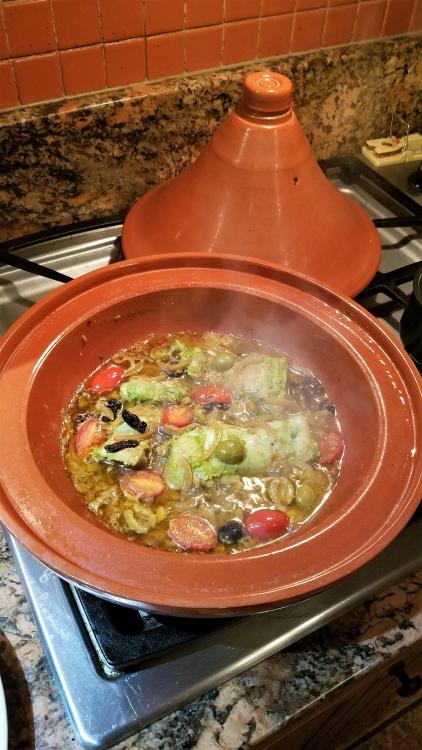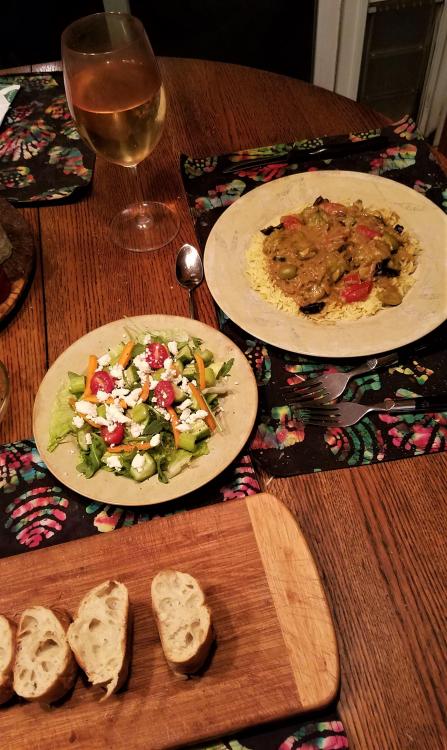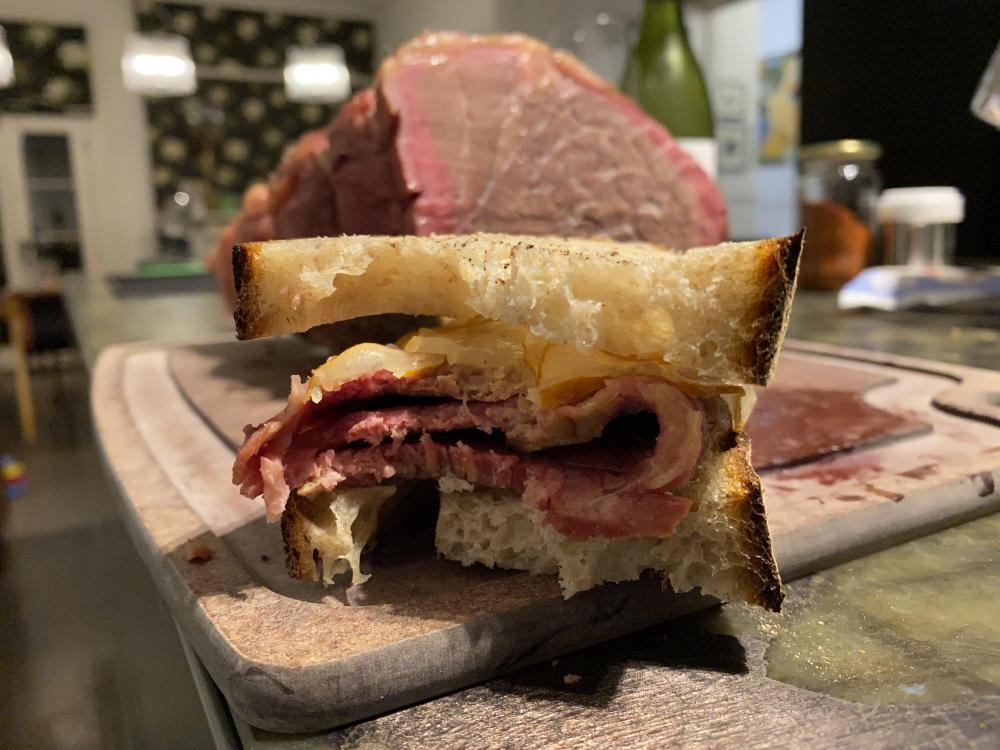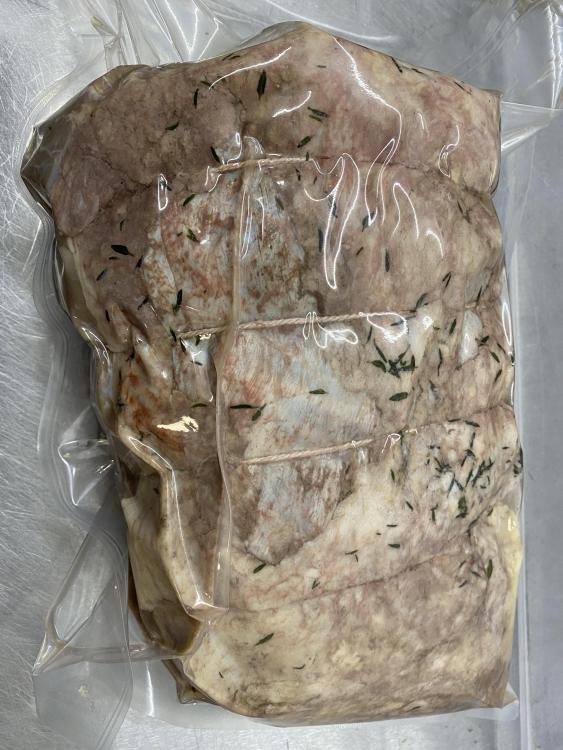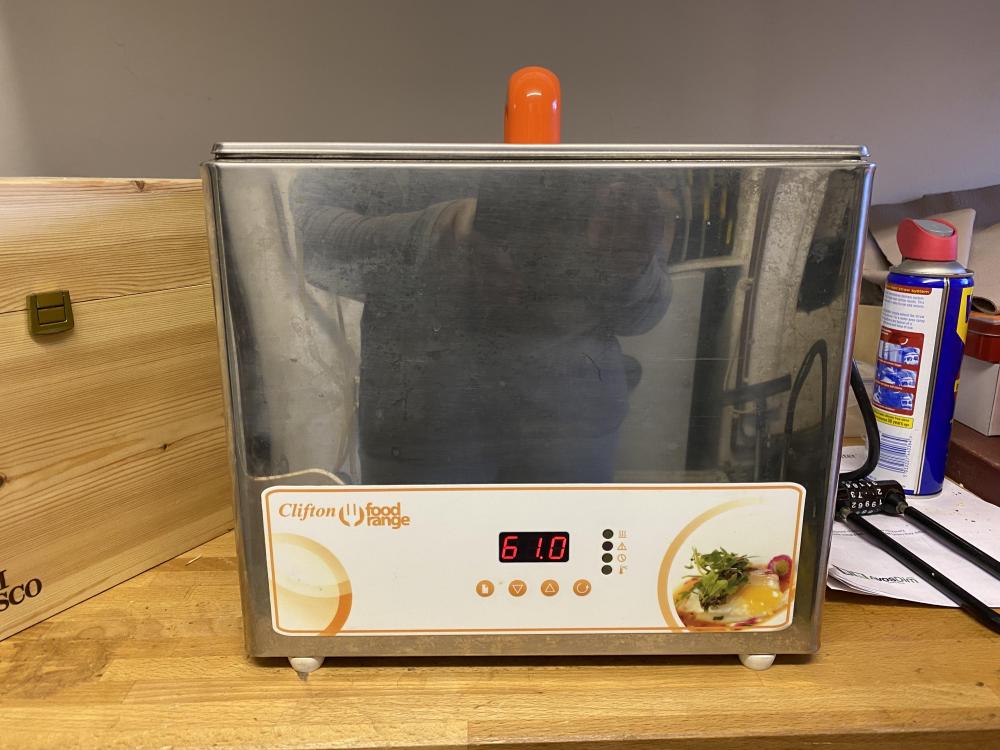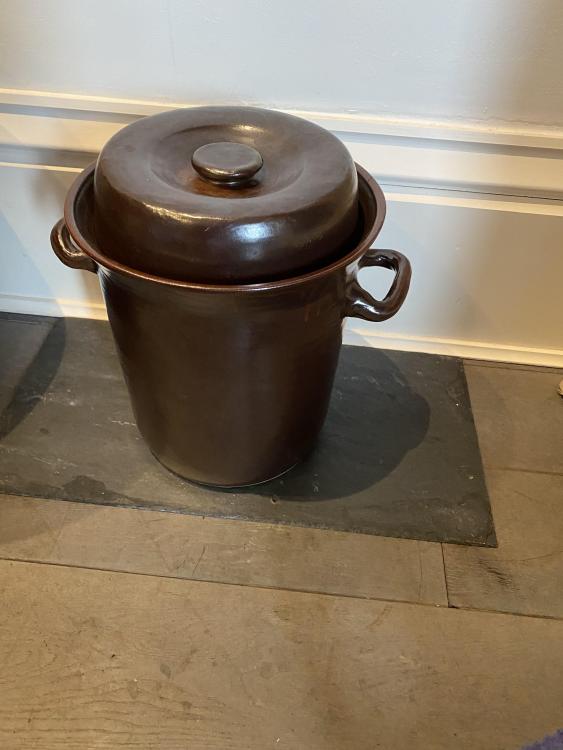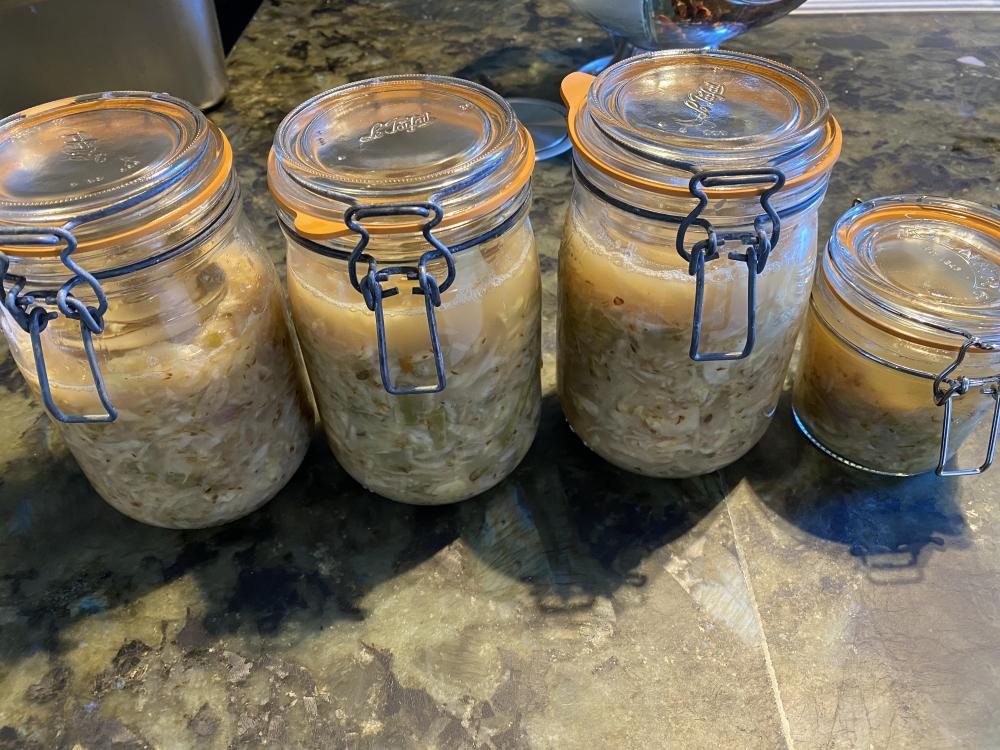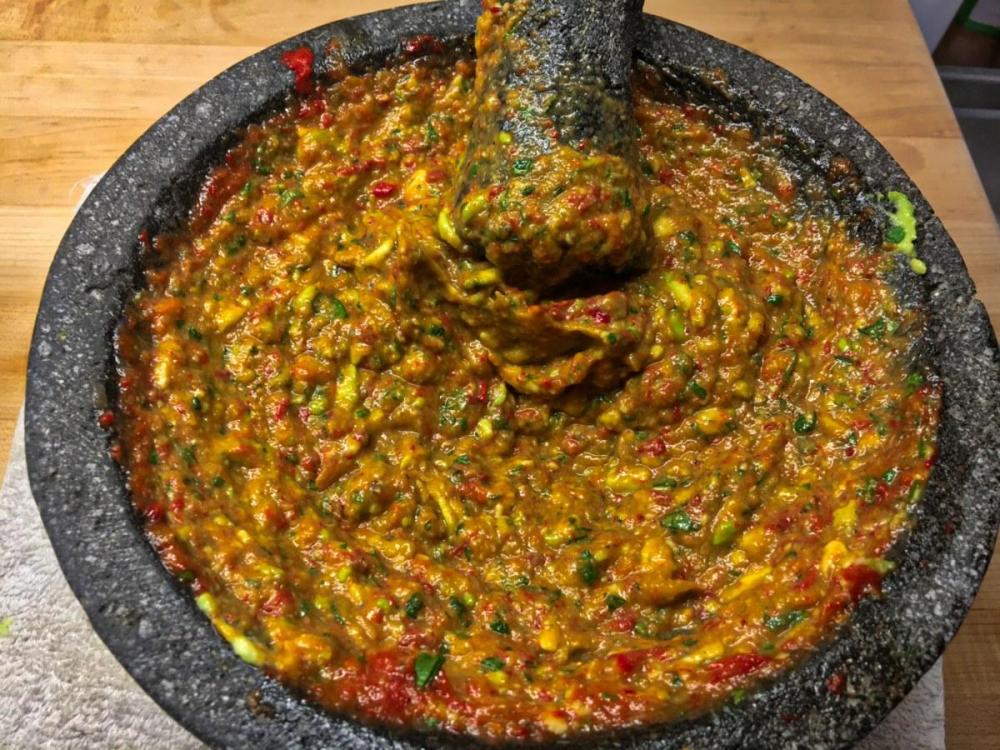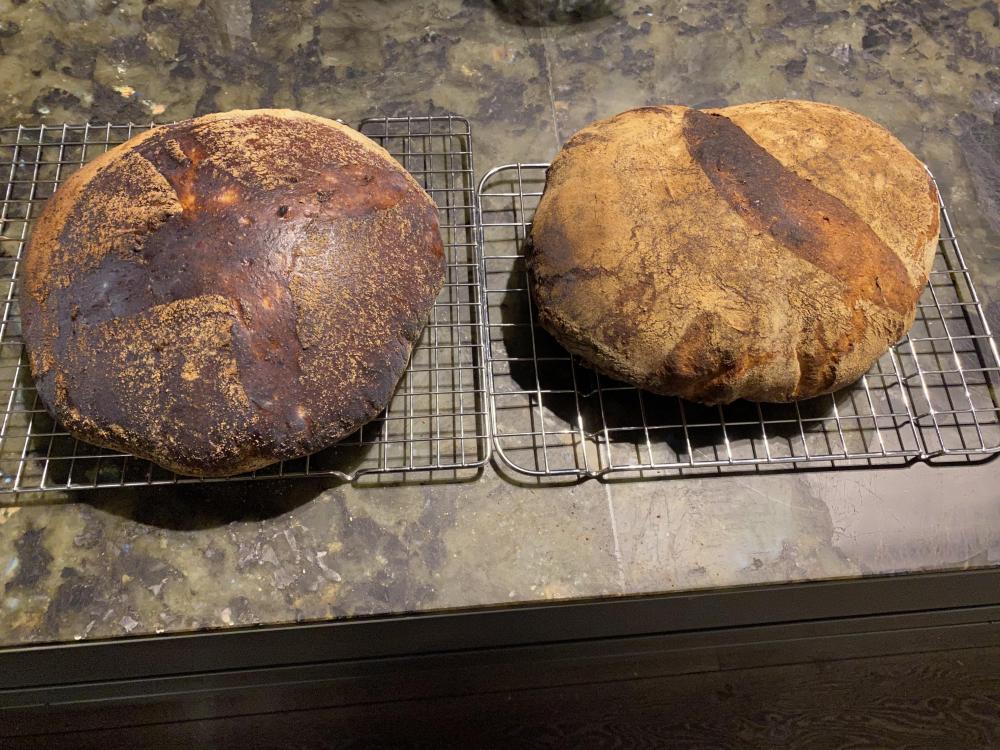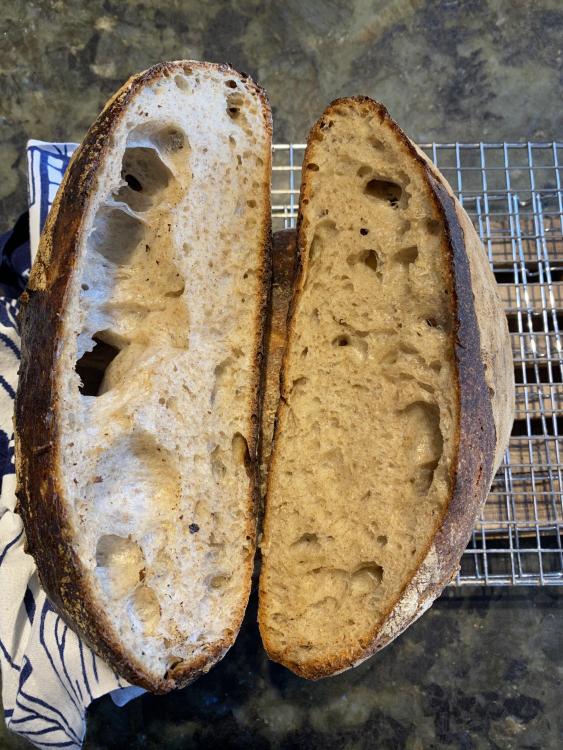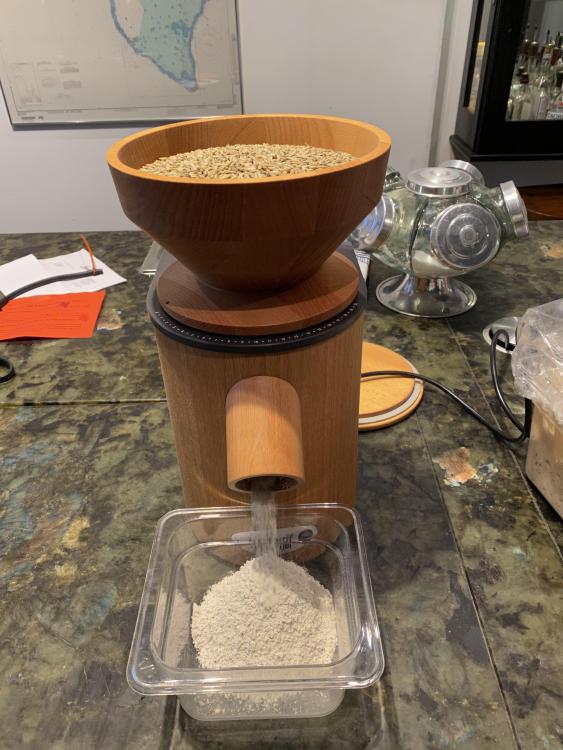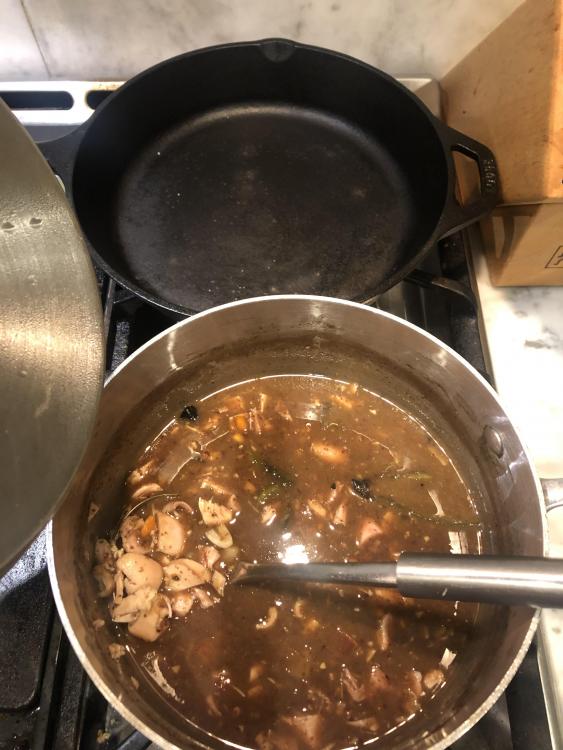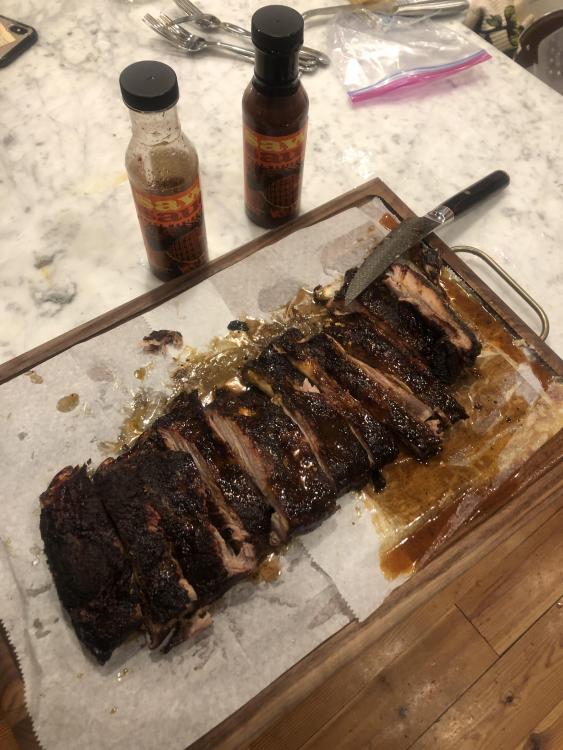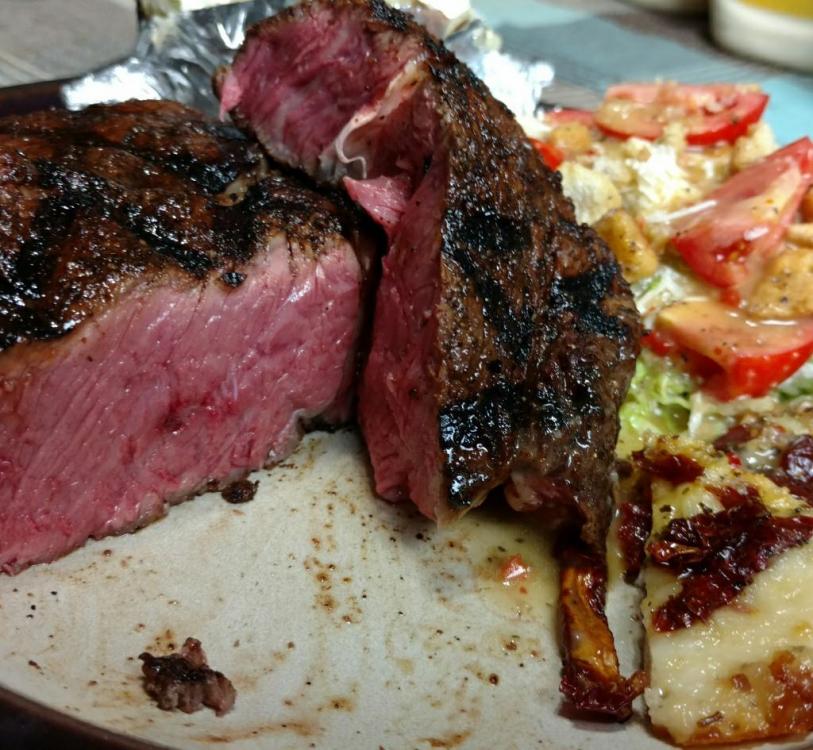Leaderboard
Popular Content
Showing content with the highest reputation on 01/15/2020 in all areas
-
Crappy weather, so I was cooking indoors last night. Had been wanting some Moroccan food, so I did a chicken tajine. Pretty traditional setup - marinated the chicken thighs (boneless/skinless) in green Harissa and EVOO for 3 hours, then seasoned with Berbere spices and browned in the tajine, removed the chicken and then browned the onions and garlic. Return the chicken thighs to the tajine and then add the green and black (salt cured) olives, preserved lemon peels, cherry tomatoes, chicken stock, lemon juice and Ras El Hanout. Here's the new twist - the recipe called for chickpeas and at the end, you mash half of them into the liquid to thicken the sauce. Well, I didn't have any cans of chickpeas/garbanzos in the pantry, but I did have some hummus in the fridge, so I tossed a couple of TB of that in to make the sauce - worked like a charm!! Served over saffron rice, with a nice side salad and crusty bread. Toss in a glass of chardonnay and call it din-din!4 points
-
We just bought the 23 Ultimate. My first cook was a smoked brisket for a tailgate (26 people). We nailed it. Go big or go home.3 points
-
Thanks All. I had to fly up North for business and landed back down South last night in the middle of a raging storm. I am sure we were safe throughout but I was sufficiently unsettled to be looking for some comfort food when I got home. Happily, the salt beef was sitting in the water bath, nice and warm on my return. Nothing fancy - a nice, comforting salt beef and pickled cucumber sandwich on rye. I made the 20% ish rye Tartine bread. Not enough rye for me so I will be trying another recipe this weekend. The salt beef? A little grey because I didn't use salt petre. Very tasty. Needs more fat. Back to brisket next time.3 points
-
Great looking dish. I've always wanted to try out a tagine. I must resist buying one, I must resist..........3 points
-
YOU'RE Seven Shuffles??? I've been shuffling EIGHT times for years because I never believed you!2 points
-
If one can come by preserved lemons (bought, or better yet, homemade), the most famous chicken tagine in Morocco is with olives and preserved lemons. One can Google many recipes. They're all pretty similar, affected more by ingredient quality and chef technique than the list of ingredients. These recipes all look authentic to me, similar to what I do. I prefer bone-in thighs, and both coriander and parsley, and I have a heavy hand with the saffron. Moroccan Chicken Tagine with Preserved Lemons & Olives CHICKEN, PRESERVED LEMON AND OLIVES TAGINE – CHICKEN MKALLI Chicken, Olive, and Lemon Tagine (Djaj Mqualli) As for the tagine clay cooking vessel, it is unnecessary. It is designed for cooking over a slow charcoal fire. Use whatever you'd use for a French stew. However, be aware that in Morocco (where I took a few lessons) they have mastered browning a wet mixture through a clay pot, without burning that same mixture. The idea is pretty obvious, if one pictures how one burns food in general: It begins to stick to the bottom of the pot, and is left unattended long enough to burn. The Moroccans have mastered this effect, and catch it in time. (Without lots of experience, this window is about as "blink and you'll miss it" hard to time as catching the al dente transition for US dried pasta. There's a reason people pay more for Italian pasta. Mexicans would let the burn go longer, but I digress.) Instead, brown the chicken separately to your satisfaction (or not) and then cook gently to avoid burning. In my twenties, I used to learn factoids and then be on alert to avoid being scammed by people who misunderstood these factoids. I learned that there are two kinds of tagines, for cooking (unglazed interior lid), and for serving (decorative glaze on all surfaces). One could only find the serving kind for sale, which somehow offended my developing sensibilities. I somehow made life an Indiana Jones contest to find the authentic. Like all things twenties, I was an idiot, and had this exactly backwards. Cooking is all theatre. People's tastes are less educated and discerning than ours, so they look to visual cues. (This principle guides all fancy restaurants.) Serving in a tagine is great theatre, even if cooking in one has only a faint effect.2 points
-
There is a professional textbook by Michel Suas that solved a problem for me that no popular book addresses: Advanced Bread and Pastry A Professional Approach (The depth of this book can be intimidating. It reveals that a trained baker can understand their craft as well as any professional in other domains.) The issue was the poor performance of "green" (as in young) flour, freshly-ground flour that has not aged. As Suas states, We of course do not want to age freshly ground flour for 2-3 weeks; besides the inconvenience, the germ that we leave in would go rancid. Even dough left in the fridge a day or two can turn an unappealing grey. Suas also notes that a long first fermentation will naturally increase dough oxidation, offsetting somewhat the ill effects of using "green" flour. Everyone's technique is different, and absolutely everything comes into play, in determining the extent that this is a problem. Hydration? Grind fineness? Fermentation schedule? I have learned to not even bring this up at farmers markets where I see bread sold from freshly ground flour. Usually the baker is oblivious to this problem, defensive when it is even suggested, and has found a way to nevertheless produce loaves with the correct appearance. This reminds me of asking food professionals about "pine mouth" toxicity from wrong species of pine nuts; any pine nut that isn't $50/pound is from the wrong species and a crap shoot. It's easy to understand this ignorance; I have many Mexican recipes that call for avocado leaves, and I was about to plant the most frost-hardy variant I could find, until I read Diana Kennedy's accounts of leaf toxicity in avocado variants not grown in Oaxaca. Now I don't know if I can trust avocado leaves in a restaurant. Some Mexican restaurants in the US even use pine nuts, too. My questions are likely to get me escorted to the door. But I digress. I was pushing the boundaries of reasonable hydration for whole wheat loaves, attempting artisan technical results that usually require somewhat less extracted flour (a Lionel Poilâne loaf is my holy grail), and my loaves were coming out like flying saucers. Then I discovered the Suas passages via Google Books. (I have since bought his book.) 40 ppm is 40 parts per million. Yikes! How does one do that, in a bakery or a home kitchen? We're not science labs here. Suas recommends carefully mixing and cutting twice with white flour, to achieve a mixture one can actually weigh on a gram scale. I mix ascorbic acid 1:20 with white flour, sieve multiple times to mix well, then mix some of that 1:20 with white flour to obtain a 1:440 blend. (There's unfamiliar ratio math here: (1:20) * (1:20) = (1:440), which we can check as 21 * 21 = 441.) For my standard recipe based on a kilogram of flour, I mix in 18 grams of this 1:440 blend. This has been an easy habit, and I no longer experiment with leaving this step out. Others might not find it necessary, but I offer it as an option, in case they're experiencing issues that they can't resolve.2 points
-
No takeaways for you Tekobo. Great effort. Sent from my iPhone using Tapatalk2 points
-
You are no chance of resisting! [emoji23] I’m expecting photos within the month. Tasty looking dish Tony Sent from my iPhone using Tapatalk2 points
-
This sandwich has been a few weeks in the making. I started the kraut exactly a month ago today, inspired by a huge, overgrown beetroot from the allotment that needed to be processed into something good. I found a recipe with that used beet, cabbage, onion and green beans. The kraut has been sitting quietly in the corner of our dining room for the last month, fermenting away in this crock pot. I tasted it today and it was just right. A bright sour taste. Into jars and into the fridge. I have made salt beef a few times using this recipe: https://www.dailymail.co.uk/home/moslive/article-1359876/Salt-beef-You-make-dont-forget-tell-half.html I usually use rolled brisket but this time I bought a hind quarter of beef and so used a silverside instead. Less fat. I hope that won't mean less taste. The salt beef has been in the cure for a week and, usually, the next step requires me to boil it for about three hours. We are going out this evening and I wondered if I could cook the salt beef sous vide instead. I looked up a few recipes online and they ranged from 48 hrs to 3 days at 60C. Given I am due to be away for work and will return at about the 60 hr limit, this seemed ideal. Here is the beef vacuum packed: I have put the sous vide machine on my husband's work bench in the plant room. I have also told him it is meant to be there and I have not forgotten it.. All that remains is to make the rye bread for the sandwich of the year. The shaped loaves are just waiting to go in the KK. I am looking forward to this sandwich. A fair bit of effort but a lot cheaper than a ticket to New York.1 point
-
Even though I was copying from a spreadsheet, I checked my math again before posting. I figured (1:20) * (1:20) = (1:440) could already wear out my welcome, so I left it out: 18 grams at 1:440 is 18/441 = .0408 grams of ascorbic acid. As a fraction of one kilo of flour, this is 40.8 parts per million. I have multiple sieves. My favorite combination is a 12 inch No. 25 test sieve over an 8 quart Vollrath bowl. Both are more expensive than alternatives, but worth the money. Gilson 12-Inch (305mm) ASTM E11 Test Sieve, All Stainless Steel, No. 25 (710µm) Opening Size, Intermediate Height (V12SI #25) Vollrath 69080 S/S 8 Qt Mixing Bowl Extraction is a variable in my spreadsheet, currently set to 85%. This however depends on the grinder and its condition and setting, the grain mix, and how completely one sieves. If I were sharing my spreadsheet with others, I'd add an obsessive/compulsive index variable. And I do use some flours (semolina, white) that aren't home ground. Currently my bread is 65% home ground. As for mixing, I don't believe that there are losses differentially favoring or discriminating against ascorbic acid. I use coarser (less expensive) sieves for mixing, alternating between two 8 quart bowls. In fact, I'm cursed for life to sieve seven times because I'm a coauthor of a famous math paper on card shuffling (Google 'Seven Shuffles'; I'm Dave). An uneven distribution of ascorbic acid is a real risk here. A greater risk, in my experience, is the mix going stale after a few years. I don't understand how this is even chemically possible (I should be able to use ascorbic acid found in Egyptian tombs, right?), but I've found it necessary to buy fresh ascorbic acid every now and then, based on observation and experience. I even have very coarse sieves intended for making couscous from scratch. Still on my todo list, and I'm instead in a Mexican phase now.1 point
-
TY! I obsessed about the KK for 3 years ... finally pulled the trigger. No buyers remorse : )1 point
-
My meater...one over from my thumb, works every time, I've had it for years.1 point
-
I have been working my way through the Tartine lexicon. I tried the rye bread from their Tartine Bread book. I found the dough a bit wet and the first loaf stuck to my peel. Used lots more flour the second time and remembered to get the steam going on the second loaf, it's the one on the left. This should make others laugh. I was very rude about @Pequod's fresh milled fun i.e. the fact that he, and others, were bothering to mill their own flour. I have given in. This is my new mill working on some rye this morning. I am going back to a 100% rye recipe that uses rye flour, rye leaven AND cooked and soaked rye grains. I last made it in 2008 and my notes in the book say it was "disastrously bad". I also said that I used too much soaked grain and that I would try again. The time has come and I will try it out later this week once the leaven has bubbled up.1 point
-
Yup. My MEATER stopped working and I returned it to the company for a fix. They looked up my online data and said I had taken the device over the recommended temp and that I had voided the warranty. Thankfully, they were nice and replaced it anyway.1 point
-
Tasty dinner, Tony, great call on the hummus. It has been ages since I've used my tagine, maybe it's time to drag it out. Speaking of dragging, I've been dragging my butt around with a miserable cold. It seems to be getting better and this tasty dish has my taste buds activated.1 point
-
1 point
-
I’m cooking a small bit of brisket flat today, ready for lunches this week. On the KK with some Jam wood for smoke, more pics to come as the cook progresses. Sent from my iPhone using Tapatalk1 point
-
Burger with the lot missed half the pics lol Sent from my SM-T835 using Tapatalk1 point
-
1 point
-
Lasagne tonight. First time in the KK. On the plate. 1.5kg of beef with greens that had to be trimmed from the new vegepod. This thing is unreal. Possum proof, grub proof, no more pests eating my veges. This was after planting seeds 6 weeks ago. Sent from my iPhone using Tapatalk1 point
-
I'm a big fan of the forward sear. It just gives a better wall to wall MD rare since you are searing raw meat. With a reverse sear you are searing meat that is basically already at temp so you end up with a gray line just under the sear. If it's a thin cut I just do a direct cook and not bother with a separate sear phase. They say a picture is worth 1,000 words. Here is a good example of a forward sear.1 point
-
@Alphonse............I do both. My rule of thumb is thicker cuts that I cook low & slow and/or SV get the reverse sear. Thinner cuts get the forward sear then go to the side to finish. I like both and will switch around for fun. It also depends on the cooker. I know ckreef does the forward sear on his Nuke Delta Argentinian style grill (as I do on my Gabby Grill - Santa Maria style) because it is easier to control the internal temp of the meat and the sear on crust. My suggestion......try both and see what you and the family like best. Follow your motto above1 point


Bull.thumb.jpg.50d347aabd71178c9d9a16b7663cfa1a.jpg)


